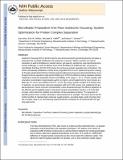Microfluidic Preparative Free-Flow Isoelectric Focusing: System Optimization for Protein Complex Separation
Author(s)
Wen, Jian; Wilker, Erik W.; Yaffe, Michael B; Jensen, Klavs F
DownloadYaffe_Microfluidic preparative.pdf (3.009Mb)
PUBLISHER_POLICY
Publisher Policy
Article is made available in accordance with the publisher's policy and may be subject to US copyright law. Please refer to the publisher's site for terms of use.
Terms of use
Metadata
Show full item recordAbstract
Isoelectric focusing (IEF) is the first step for two-dimensional (2D) gel electrophoresis and plays an important role in sample purification for proteomics. However, biases in protein size and pI resolution, as well as limitations in sample volume, gel capacity, sample loss, and experimental time, remain challenges. In order to address some of the limitations of traditional IEF, we present a microfluidic free flow IEF (FF-IEF) device for continuous protein separation into 24 fractions. The device reproducibly establishes a nearly linear pH gradient from 4 to 10. Optimized dynamic coatings of 4% poly(vinyl alcohol) (PVA) minimize peak broadening by transverse electrokinetic flows. Even though the device operates at high electric fields (up to 370 V/cm), efficient cooling maintains solution temperature inside the separation channel controllably in the range 2−25 °C. Protein samples with a dynamic concentration range from μg/mL to mg/mL can be loaded into the microdevice at a flow rate of 1 mL/h and residence time of 12 min. By using a protein complex of nine proteins and 13 isoforms, we demonstrate improved separation with the FF-IEF system over traditional 2D gel electrophoresis. Device-to-device reproducibility is also illustrated through the efficient depletion of the albumin and hemoglobin assays. Postdevice sample concentrations result in a 10−20-fold increase, which allow for isolation and detection of low abundance proteins. The separation of specific proteins from a whole cell lysate is demonstrated as an example. The microdevice has the further benefits of retaining high molecular weight proteins, providing higher yield of protein that has a broader range in pI, and reducing experimental time compared to conventional IEF IGP gel strip approaches.
Date issued
2010-01Department
Massachusetts Institute of Technology. Department of Biological Engineering; Massachusetts Institute of Technology. Department of Biology; Massachusetts Institute of Technology. Department of Chemical Engineering; Koch Institute for Integrative Cancer Research at MITJournal
Analytical Chemistry
Publisher
American Chemical Society (ACS)
Citation
Wen, Jian et al. “Microfluidic Preparative Free-Flow Isoelectric Focusing: System Optimization for Protein Complex Separation.” Analytical Chemistry 82.4 (2010): 1253–1260.
Version: Author's final manuscript
ISSN
0003-2700
1520-6882